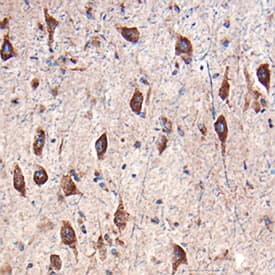Human AgRP/ART Antibody
R&D Systems, part of Bio-Techne | Catalog # AF704


Key Product Details
Species Reactivity
Validated:
Human
Cited:
Mouse
Applications
Validated:
Immunohistochemistry, Western Blot
Cited:
Immunohistochemistry
Label
Unconjugated
Antibody Source
Polyclonal Goat IgG
Product Specifications
Immunogen
S. frugiperda insect ovarian cell line Sf 21-derived recombinant human AgRP/ART
Ala21-Thr132
Accession # O00253
Ala21-Thr132
Accession # O00253
Specificity
Detects human AgRP/ART in direct ELISAs and Western blots. In Western blots, approximately 40% cross-reactivity with recombinant mouse AgRP/ART is observed.
Clonality
Polyclonal
Host
Goat
Isotype
IgG
Scientific Data Images for Human AgRP/ART Antibody
AgRP/ART in Human Brain.
AgRP/ART was detected in immersion fixed paraffin-embedded sections of human brain (hippocampus) using Goat Anti-Human AgRP/ART Antigen Affinity-purified Polyclonal Antibody (Catalog # AF704) at 15 µg/mL overnight at 4 °C. Before incubation with the primary antibody tissue was subjected to heat-induced epitope retrieval using Antigen Retrieval Reagent-Basic (Catalog # CTS013). Tissue was stained using the Anti-Goat HRP-DAB Cell & Tissue Staining Kit (brown ; Catalog # CTS008) and counterstained with hematoxylin (blue). Specific labeling was localized to the cytoplasm of neurons. View our protocol for Chromogenic IHC Staining of Paraffin-embedded Tissue Sections.Applications for Human AgRP/ART Antibody
Application
Recommended Usage
Immunohistochemistry
5-15 µg/mL
Sample: Immersion fixed paraffin-embedded sections of human brain
Sample: Immersion fixed paraffin-embedded sections of human brain
Western Blot
0.1 µg/mL
Sample: Recombinant Human AgRP/ART (Catalog # 704-AG)
Sample: Recombinant Human AgRP/ART (Catalog # 704-AG)
Formulation, Preparation, and Storage
Purification
Antigen Affinity-purified
Reconstitution
Reconstitute at 0.2 mg/mL in sterile PBS. For liquid material, refer to CoA for concentration.
Formulation
Lyophilized from a 0.2 μm filtered solution in PBS with Trehalose. *Small pack size (SP) is supplied either lyophilized or as a 0.2 µm filtered solution in PBS.
Shipping
Lyophilized product is shipped at ambient temperature. Liquid small pack size (-SP) is shipped with polar packs. Upon receipt, store immediately at the temperature recommended below.
Stability & Storage
Use a manual defrost freezer and avoid repeated freeze-thaw cycles.
- 12 months from date of receipt, -20 to -70 °C as supplied.
- 1 month, 2 to 8 °C under sterile conditions after reconstitution.
- 6 months, -20 to -70 °C under sterile conditions after reconstitution.
Background: AgRP/ART
References
References
- Martin, N.M. et al. (2006) Peptides 27:333.
- Fan, W. et al. (1997) Nature 385:165.
- Ollmann, M.M. et al. (1997) Science 278:135.
- Arora, S. and Anubhuti (2006) Neuropeptides 40:375.
- Shutter, J.R. et al. (1997) Genes Develop. 11:593.
- Kiefer, L.L. et al. (1998) Biochemistry 37:991.
- Jackson, P.J. et al. (2002) Biochemistry 41:7565.
- Fong, T.M. et al. (1997) Biochem. Biophys. Res. Commun. 237:629.
- Breit, A. et al. (2006) J. Biol. Chem. 281:37447.
- Katsuki, A. et al. (2001) J. Clin. Endocrinol. Metab. 86:1921.
- Small, C.K. et al. (2001) Diabetes 50:248.
- Vink, T. et al. (2001) Mol. Psychiatry 6:325.
- Dardennes, R.M. et al. (2007) Psychoneuroendocrinology 32:106.
- Doghman, M. et al. (2007) Mol. Cell. Endocrinol. 265 - 266:108.
Long Name
Agouti-related Protein
Alternate Names
ART
Gene Symbol
AGRP
UniProt
Additional AgRP/ART Products
Product Documents for Human AgRP/ART Antibody
Product Specific Notices for Human AgRP/ART Antibody
For research use only
